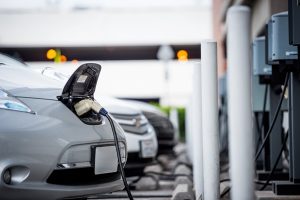The commercial International Energy Conservation Code (IECC) committee approved codes proposed by the Southwest Energy Efficiency Project (SWEEP) and other groups. The codes require new commercial and high-rise residential buildings to provide for low-cost and easy installation of EV charging. said Matthew Frommer. senior transportation associate for SWEEP.
The codes call for 20% of parking spaces in new commercial buildings to have EV-capable infrastructure. which is the electrical panel capacity and physical pathway to install a future EV charging station. Another two spaces will be EV-ready. which includes a circuit breaker and a wire terminating in a 240-volt outlet that allows for EV charging. Frommer said.
This means that people who purchase cars with Level 2 chargers won’t need to purchase their own charging station. he said.
States can choose whether to adopt the new code. which could boost sales of electric vehicles. And more electric vehicles creates opportunities for the vehicles to support the grid. said Frommer.
Grid benefits
Because cars are generally parked 95% of the time. they are flexible loads. Users can charge them at times that are beneficial to the grid. For example. during night time off-peak demand periods. they could be charged utilizing wind power that often flows at night. This could make use of excess wind power resources and reduce wind power curtailment. Frommer said.
Electric vehicle drivers could take advantage of utility time-of-use rates that provide lower rates during off-peak hours. And. with more electric vehicle charging on their systems. utilities could boost revenues — without having to build new peaker plants.
The potential result: utilities sell more electricity. rates drop and everyone benefits.
California’s experience supports this idea. said Frommer.
SWEEP has looked at data from California’s two largest utilities. Southern California Edison and Pacific Gas &. Electric. finding that for every dollar the companies spend on charging stations. they get back $2 in revenues.
“All that profit reduces rates.“ Frommer said.
The codes can help realize such benefits by significantly lowering the cost of installing charging equipment (which is increasingly configured into microgrids). If electric vehicle infrastructure is installed in new buildings. retrofit costs are avoided. Retrofits to make way for electric vehicle charging are five to six times higher than the cost of equipping new construction. said Frommer.
The next step in the code adoption process is a public hearing. In addition. in the fall. the members of ICC will vote. SWEEP plans to reach out to these members and educate them about the benefits of the code. If the code is adopted into the 2021 National Model Building Code — and the International Energy Conservation Code — some states will automatically adopt the conservation code. others will decide whether to make it part of their building codes. explained Frommer.
The ICC National Model Building Code is the overarching building code that’s adopted all over the world.
Not for homes
The ICC adopted the electric vehicle code proposal for commercial buildings. but the committee overseeing residential codes rejected that proposal. partly because building contractors make up a large part of the residential committee. and generally oppose adding codes that boost the cost of home building. said Frommer.
At this time. there are no national electric vehicle codes. However. some states and cities have implemented measures similar to this code — the city of Atlanta. for example. he said.
If the code helps put more electric vehicles on the road. it will provide more than grid benefits. Electric vehicle are three times more efficient than cars with traditional combustion engines. said Frommer.
Electric vehicle as an environmental tool
And of course. electric vehicles offer environmental advantages.
“EVs result in fewer emissions and cleaner air for everyone. particularly a lot of these counties in non-attainment areas. with ground-level ozone and other pollutants. EVs are a great tool to clean up our air.“said Frommer.
Between 2017 and 2018. electric vehicle sales in the US grew by over 80%. Yet the lack of access to charging infrastructure continues to be a barrier to electric vehicle adoption.
SWEEP partnered with New Building Institute. Edison Electric Institute. and Alliance to Save Energy to develop the code proposal.
 Iran Energy News Oil, Gas, Petrochemical and Energy Field Specialized Channel
Iran Energy News Oil, Gas, Petrochemical and Energy Field Specialized Channel




